Pick which bible translation is best for you with Chad Harrington’s matrix chart and detailed descriptions of five top recommendations.
People ask, “Which Bible translation is best?” Well, that’s a difficult question to answer on a few fronts. There’s no “best” translation, in one sense, and I learned even in elementary school that “best” must be qualified. So here’s my shot at answering this challenging question.
A Few Notes to Keep in Mind
Before I answer the question about the best Bible translation, a few qualifications.
1. There’s No Perfect Bible Translation
First, let me say that there’s no perfect translation; they’re unique voices that offer different vantage points. God inspired only the original “autographs” (the original documents of the Bible). While he has guided and guarded the preservation of those documents throughout history, we must remember that God never promised divinely inspired translations. That’s an important nuance to keep in mind here.
Take the KJV for example, because many people in the United States treat that one like it’s divinely inspired: this translation is imperfect because the translators used only five manuscripts from which to translate! Today, scholars have many more manuscripts, codices, and epigraphical data from which to make translational decisions. The KJV was fine at the time (and is fine today for those who prefer archaic language), but it’s not a holier-than-thou translation; it’s another translation with pros and cons.
Spoiler alert: I know it’s a sacred translation to some, so take this with all the respect you’re due (if that’s you): I don’t recommend the KJV because the language is so antiquated and hard to understand! There are much better translations out there today for modern readers.
2. This Is My Educated Opinion
Second, my opinion of what’s “best” is, of course, biased. I come from a tradition called “The Restoration Movement” (also called the “Stone-Campbell Movement”), I have my own life experiences, and I have educational biases having studied at Ozark Christian College and Asbury Theological Seminary; so my perspective is naturally biased (and limited).
3. These Are My Friendly Recommendations
Third, my best list includes what I would recommend to friends. So what you read below is my friendly recommendation for most people—my best recommendations; you will have a different list I’m sure! I have found these translations helpful, accurate to my knowledge of Greek and Hebrew, and containing easy-to-understand language (with varying degrees, as you’ll see).
A Note on Bible Translation Charts
One more tidbit before I give you my list: I have put together a Bible translation matrix that provides two intersecting spectrums. Most Bible translation charts have just one spectrum, usually like this:
This is totally fine! But it’s a linear approach that’s focused only on language translational differences, when it’s more complex than that. We’re not dealing with language only but also with culture and idioms.
I suggest a matrix approach to Bible translation charts.
This takes into account both language and cultural differences between translations. I got this notion from Old Testament scholar and NLT translator of Judges, Lawson Stone, who first shared this notion with my Hebrew class at Asbury. I offer it to you because Stone’s insight is uniquely insightful.
This is my own iteration of what he taught, with my own scale applied:
- Language on a scale from 1–10:
- Word for Word (1)
- Thought for Thought (10)
- Culture on a scale from 1–10:
- Ancient Culture (1)
- Modern Culture (10)
It might look like this:
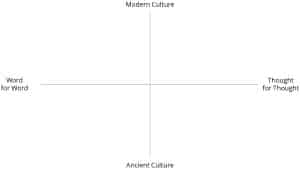
Five Best Translations for Everyday Christians
I respect other translations not listed below, but these are my top five recommendations for everyday Christians.
In a comment, let me know what your favorite is and why!
If you decide to purchase any of these Bibles, please use the affiliate links we provide here to keep our recommendations resource tool free.
1. New Revised Standard Version (NRSV) by Zondervan
I really, really like the NRSV. For ease of reading—relaxing because I trust the translation to be very close to the literal Greek and Hebrew—I choose this one.
Now, I didn’t grow up reading it (instead, the NIV), but sometimes I wish I had, it’s so good. My first exposure to it was reading The New Interpreter’s Bible Commentary Vol. IX on Romans. I found that when I wrestled with the high-level concepts of Paul’s rich theology in the Greek text, that the NRSV’s translation in that commentary was super helpful, without bogging down the reader in technicalities.
The language is very literal and to the point, but for modern cultural contexts, it also has an edge to it. This gives the serious student of the Bible confidence in a more “literal” translation with solid cultural applications for today.
On the language-culture matrix:
- The NRSV’s language translation is a 2 out of 10 on the word-for-word to thought-for-thought scale: It’s very word for word, instead of thought for thought.
- The NRSV’s cultural translation of idioms is a 3 out of 10 on the ancient verses modern scale: It largely sticks to the original figures of speech instead of translating them to modern ways of talking.
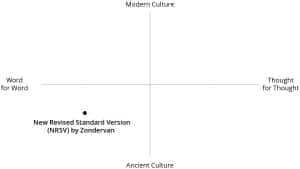
Learn more about this translation from the publisher here.
Note: They just released the NRSVue, which you can buy here. Christianbook.com says of it:
Continuing the legacy of the New Revised Standard Version, the NRSVue aims to faithfully serve the church in personal spiritual formation, in the liturgy, and in the academy. With revisions based on new textual evidence, historical insights, and linguistic precision, this updated edition delivers a translation of Scripture based on meticulous care for accuracy and readability.
2. New International Version (NIV, 1984) by Zondervan
My first love! This would have come first on the list if it were still in print! But alas, only the 2011 version remains in print, so it’s #2. I memorized Scripture in the NIV 1984 growing up, so it’s my heart translation.
The NIV 2011 version is the most common translation authors I work with at HIM Publications and YouPublish use when writing books for Christian audiences. In part, that’s because it’s available for easy use on biblegateway.com for free, which makes it easy for authors to add to nonfiction book manuscripts.
While the 2011 version is close to the 1984 version in many ways, I don’t recommend it because of its mishandling of gendered nouns and pronouns. To me, the original language of the Bible is important on this issue.
The NIV offers very down-to-earth language that translates into various dialects of English around the world.
On the language-culture matrix:
- The NIV’s language is a 4 out of 10 on the word-for-word to thought-for-thought scale: It’s between word for word and thought for thought, with a slight penchant for the literal meaning of a word.
- The NIV’s cultural translation of idioms is a 4 out of 10 on the ancient verses modern scale: It will often translate figures of speech in modern language, but when there could be a doubt, they lean toward the ancient idiom side.
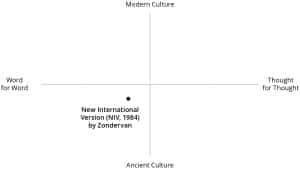
Little known fact: The NIV’s translation committee is governed by an entity that ensures it is perpetually retranslated over time as English cultures change.
Who is responsible for translating and maintaining the NIV?
While Zondervan is the North American publisher, it’s Biblica (previously “International Bible Society”) who holds the copyright. Biblica uses royalties to fund foreign-language translations in the world’s top 100 languages. Further, it’s the Committee on Bible Translation (CBT) who has standards by which to keep the translation up to date as time goes on.
Learn more about this translation here. Interesting note about the translation committee standard from that article:
The translators come from many different denominations and they only make changes to the English translated text if 70% or more of the committee agrees, safeguarding the NIV translation against theological and ideological bias.
3. New Living Translation (NLT) by Tyndale
Until I got to know the inner workings of the mind of one of the translators for the New Living Translation, I had dismissed it. But when my Hebrew professor, Lawson Stone, guided our class at Asbury through Judges 1–5, I realized: This dude’s legit!
His knowledge of the original languages is bar-none, and his way of thinking about language in general instills confidence in me that the NLT is an excellent and responsible thought-for-thought, modern culture translation of the Bible.
For those who want a metaphorical slow-river canoe ride of an experience reading through the Bible that feels like spreading warm butter on a slice of lightly toasted sourdough bread—this translation’s for you!
It’s easy to read and understand.
When I read it, it gives me a strong sense of connection to the authors, and to God himself. I highly recommend it!
On the language-culture matrix:
- The NLT’s language is a 7 out of 10 on the word-for-word to thought-for-thought scale: It’s very much a thought for thought handling of language but not as much as The Message.
- The NLT’s cultural translation of idioms is a 7 out of 10 on the ancient verses modern scale: You will usually get modern cultural applications of the same idioms from the translators’ understanding of the ancient figures of speech.
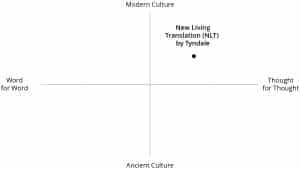
The NLT has put out the Immerse Bible reading series that’s an incredibly beautiful contribution to the English speaking world. It’s also super helpful for those who want to follow my “how to do a book study” project in my “How to Read the Bible” course.
Learn more about the NLT from the publisher here.
Here’s the publisher’s description of the NLT, pasted from that link, for reference:
The New Living Translation combines the latest biblical scholarship with a clear, dynamic writing style that communicates God’s Word powerfully to all who hear and read it. It renders the message of the original texts of Scripture into clear, contemporary English that was written to be read aloud. With a focus on clarity, The New Living Translation invites readers to go deeper into the biblical text to discover God’s story for their lives and the world.
4. English Standard Version (ESV) by Crossway
When the ESV first came out in the early 2000s, I considered it anathema. Who would try to take the place of my beloved NIV! Then, I realized that it was legitimate—similar to my NLT realization. My professors at Ozark and my own experience showed me its legitimacy.
Crossway has done a great job with this translation. It’s very close to the NIV, but this translation’s committee is constitutionally different than the NIV’s. Most of them are from the Reformed tradition, so the committee’s perspective is more theologically distinctive.
Since I’m not from the Reformed tradition, this didn’t make my top-of-list, but maybe it would if I were! While I don’t agree with some of the theological underpinnings that undergird key translational decisions about key issues for me (like predestination), I think the committee did a great job.
The ESV is like the NIV: It’s a word-for-word translation without archaic cultural translations.
On the language-culture matrix:
- The ESV’s language is a 3 out of 10 on the word-for-word to thought-for-thought scale: It’s in between word for word and thought for thought, with a slight penchant for literal meanings, even one degree more than the NIV.
- The ESV’s cultural translation of idioms is a 4 out of 10 as well on the ancient verses modern scale: Like the NIV, they will often translate figures of speech in modern language, but when there’s a question, they seem to translate those in ancient idiomatic language still.
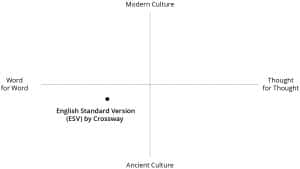
5. The Message by NavPress (2002)
Finally, The Message! I might get some flak for this one, because years ago I would have given myself flak for recommending this “translation.”
While technically, it’s not a translation in the proper sense of the term as most understand it—but instead a “paraphrase”—I’ll call it a translation for the simple fact that it’s a translation in the broadest sense of the term.
A paraphrase is at the far extreme of the thought-for-thought side of the translation language scale.
On the language-culture matrix:
- The Message’s language is a 10 out of 10 on the word-for-word to thought-for-thought scale: It offers a totally thought-for-thought handling of the language, where the aim is not to give a one-for-one translation for each word but a similar thought for each thought used—even some words falling out because they’re part of a translated thought.
- The Message’s cultural translation of idioms is a 10 out of 10 on the ancient verses modern scale: You will only get modern cultural translations of idioms (no ancient figures of speech).
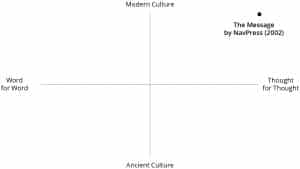
The story behind this translation by Eugene Peterson is compelling: As a pastor in Bel Air, Maryland, he wanted a way for his small-town congregation in the Presbyterian tradition to easily grasp the heart and meaning of the Bible. He loved the church and wanted to disciple them in the Word.
Peterson is an excellent, albeit imperfect, handler of the ancient languages in practice and in pedigree.
Watch this video here about the translation.
Okay, one more: watch this video here about U2’s Bono’s experience of The Message’s translation of the Psalms.
I recommend The Message to you for a change up, something to ignite your burned-out soul. It should not be one’s only translation, but it’s a great supplement to other translations to gain perspective.
A Piece of Advice about Translations in General
If you’re used to one translation, try a new translation from the list above—give it a whirl! See what pops out afresh and intrigues your heart in a new way. Then go back to your translation of choice with fresh perspective.
Again, no translation is perfect, and the translations I’ve listed above run the spectrums across the matrix of language and culture.
Putting These Five Best Translations on the Matrix:
It might look like this:
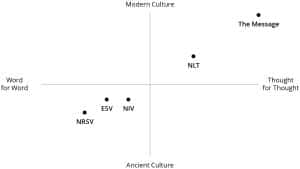
Which translation is your favorite? Why? Are you going to try a new one from this list? Why?
Chime in via comment below!

(1) We need to recognize that cultural updates, without regard to whether we view it as a positive or a negative, one must ask the question “whose culture ? The answer is highly impactive upon any update translation. Is this a culture where a child is driven to local soccer practice or soccer practice is not feasible because the school dosen’t have soccer and community soccer programs are twenty minutes away, twice as long via public transportation. Is this a culture where Sunday family dinner includes Mom, Dad and the kids, or a culture where Sunday dinner means aunts, uncles, cousins and the neighbor down the street, or where family dinner together is whatever day of the week you can manage, because it has to be pre-planned due to.differences in work schedules/geographic locations? Is this a culture where a responsible child is the one that grows up to be self sufficient requiring nothing from parents because it’s their turn, parents are now free to live their lives; or a culture where the responsible child is the one that grows up, is welcome and expected to rely on parents who would be hurt and offended if you live as if you don’t need them; or where the responsible child grows up and is expected to now provide for parents. The scripture ” Honor your father and mother…” takes on a different perspective. These are generalized examples in an effort not to provide an opening for divisive cultural differences.
(2) Personally I like to read (study) more than one translation on a regular basis. I highly recommend it. One of my favorite scriptures is Roman’s 8:28 Sometimes I need the affirmation – “ALL things WORK TOGETHER for good….” KJV, NKJV,
Sometimes I need the reassurance – “GOD CAUSES everything to work together for good….” NAS, NLT
Other times it’s the knowledge that “IN ALL things God works …. NIV, [ emphasis added ]
Surprised by your love for NRSV hesitation w/ESV since the later is a revision of RSV w/out the gender-neutral language. Again, surprised by your dislike of NIV2011 b/c of gender changes. Don’t necessarily disagree b/more confused.
Thanks for the article.
Thanks for the input!
Thanks for your mention of Lawson Stone. Great educator.
Yes!